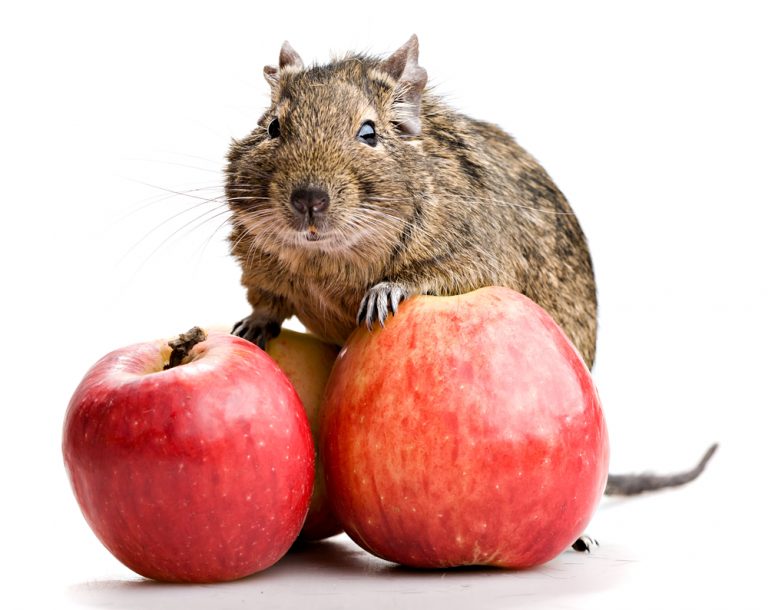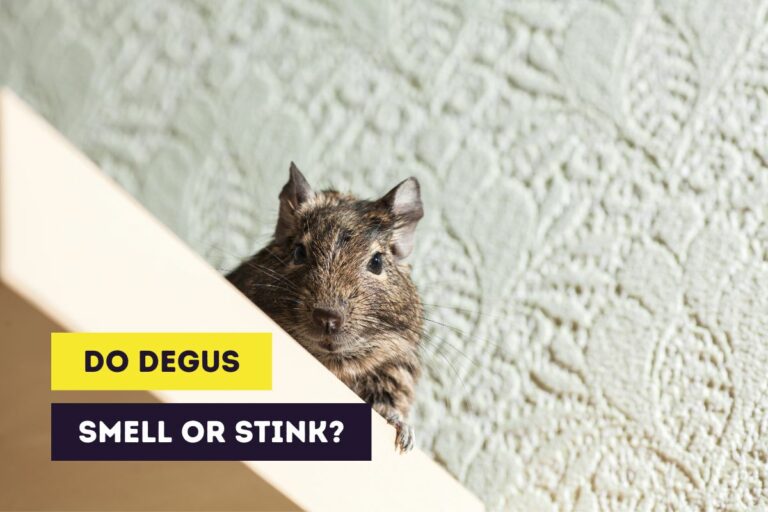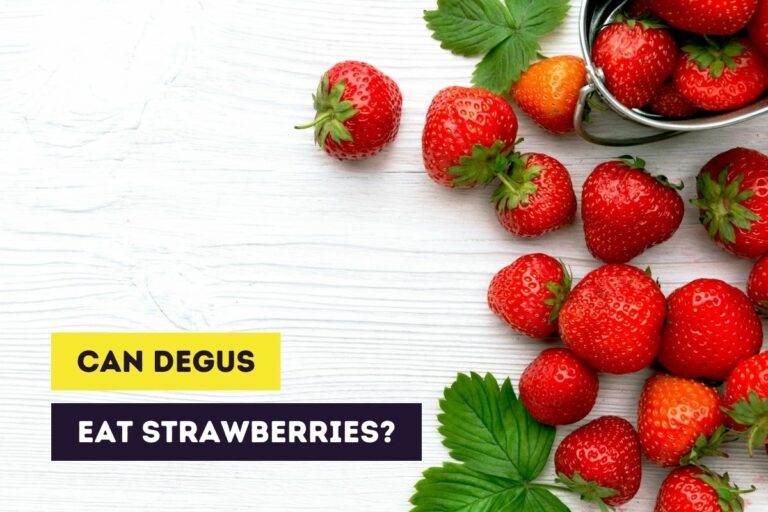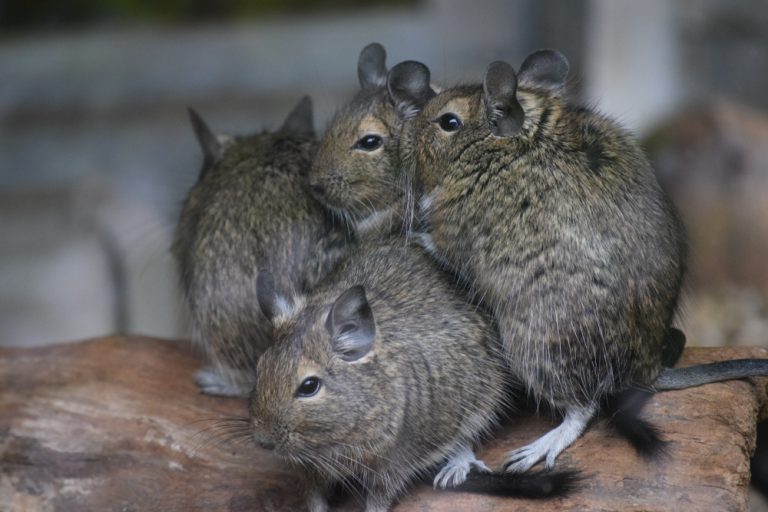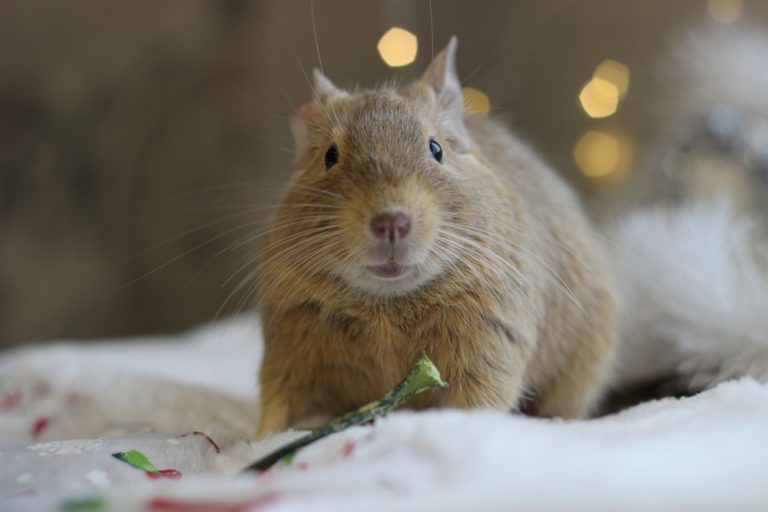Can Degus Eat Hay? Benefits, Dangers & Instructions
A degu diet shouldn’t consist solely of pellets or seed mix. These tiny pets also need roughage (fibers) in their diet and a well-known source of fibers is hay. But can degus eat hay, or should hay be avoided as a food source?
Although hay is healthy and necessary for most degus, you’ll need to take some precautions to prevent your degus from getting sick. These precautions are fairly straightforward and easy to follow. So, let’s find out more about hay!
This site contains affiliate links to products we recommend and use ourselves. We may receive a commission for purchases that you make through these links. If you’re interested in learning more about our affiliate links, please visit our (affiliate) disclaimer.
Do Wild Degus Eat Hay?
Wild degus are herbivores that feed on leaves, bark, and seeds of shrubs. They will eat green grasses when they’re available. Wild degus also choose food that increases the moisture in their diet; grasses are perfect for this.[1]See for example https://animaldiversity.org/accounts/Octodon_degus/#food_habits and https://lafeber.com/vet/basic-information-for-degus/ Just like some other rodents, degus are known to graze on grasses in their natural habitat, which is shrubland and grassland in Chile.[2]https://nationalzoo.si.edu/animals/degu
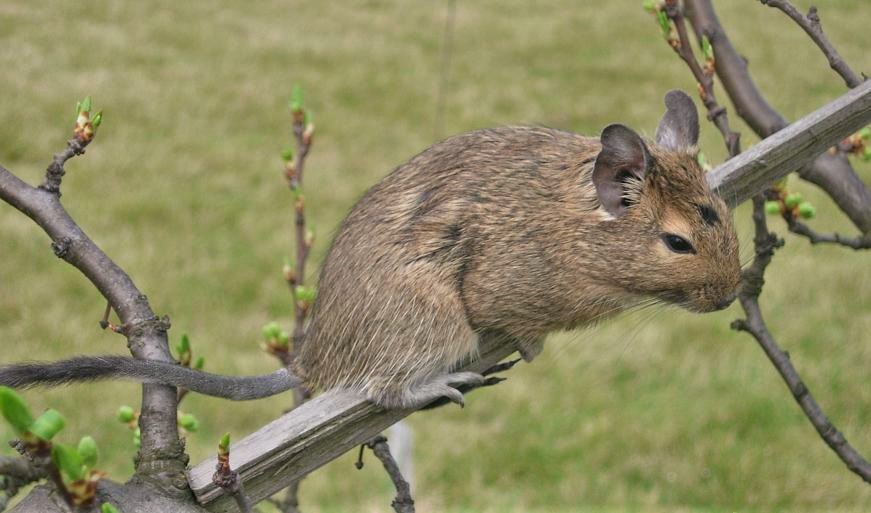
Approximately 60% of their natural diet consists of these grasses.[3]Edwards, M. (06 2009). Nutrition and Behavior of Degus (Octodon degus). The veterinary clinics of North America. Exotic animal practice, 12, 237–253, viii. doi:10.1016/j.cvex.2009.01.003 These grasses have a hay-like texture in dry seasons. So, in their natural habitat degus eat grass and dried grass (hay) but what are the benefits and possible dangers of feeding hay to your pet degus?
Benefits of Eating Hay
Degus are strict herbivores, meaning they only consume plant matter. Their diet consists of vegetables, herbs, and also grasses. Grasses and hay should be the largest percentage of a degu’s diet.[4]https://www.rspca.org.uk/adviceandwelfare/pets/rodents/degus/diet Degus get several benefits from eating hay.
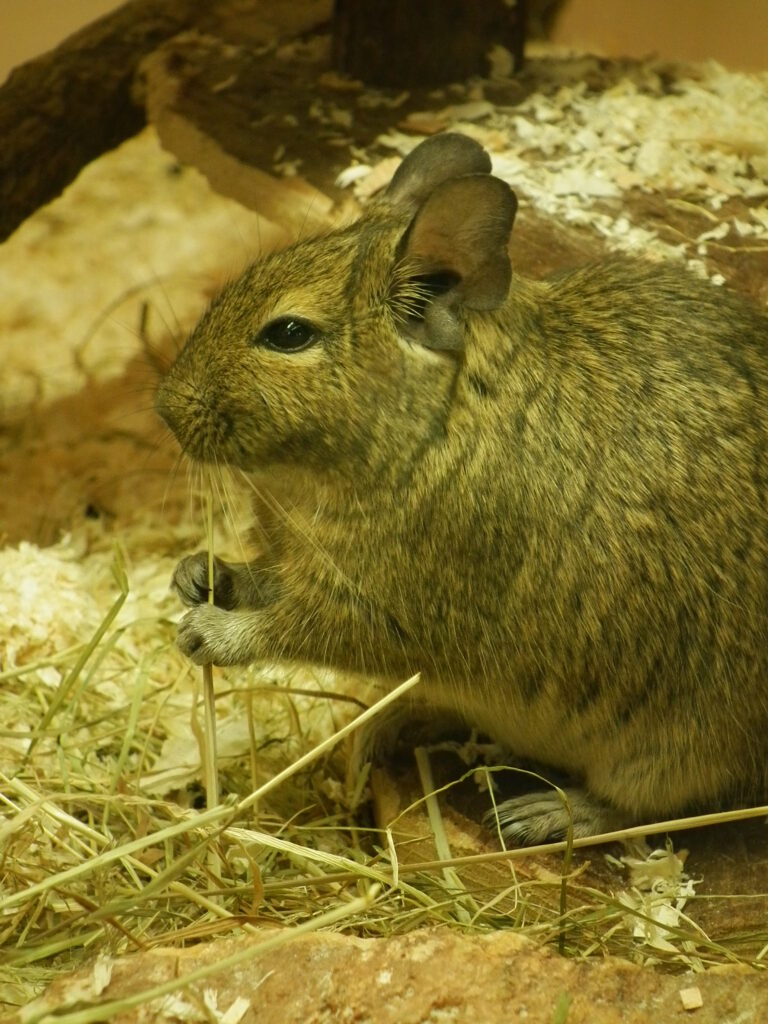
High fiber content
Degus need enough fibers in their diet. Hay and grass are excellent sources of fibers. In the table below, you can find the percentages of fiber in different hay species that can be found in pet stores or online.
| Hay species | Fiber percentage |
|---|---|
| Timothy hay | 35.6% |
| Orchard hay | 32.0% |
| Meadow hay | 32.0% |
| Alfalfa hay | 32.0% |
Calcium
Calcium is a mineral that is essential for most animals. The mineral is necessary for several bodily functions and to build strong bones and teeth. Since degus’ teeth never stop growing, it’s very important that your degus get enough calcium in their diet. However, you also don’t want to feed too much calcium because this can also be harmful.
Most hays contain a lot of calcium and have a good calcium to phosphorus ratio. Hay adds a little calcium to your degu’s diet. However, most degus will get enough calcium from their pellets and other vegetables you provide.
In the table below, you can find the ratio in different hay species.
| Hay species | Ca:P ratio |
|---|---|
| Timothy hay | [1.57]:[1] |
| Orchard hay | [1.5]:[1] |
| Meadow hay | [1.3]:[1] |
| Alfalfa hay | [5.3]:[1] |
Chewing material
A lack of chewing material can also cause the teeth not to wear out properly, which can cause malocclusions. When your degus have dental issues, they will have it more difficult to eat. It might even be impossible for them to eat properly.[5]Meredith, A., & Redrobe, S. (2002). BSAVA manual of exotic pets (No. Ed. 4). British Small Animal Veterinary Association.
Grass and grass hay is an excellent and cheap chewing material. Degus will need to chew thoroughly on the hay to be able to eat it. This will keep your degus busy for hours and help keep their teeth in perfect condition.
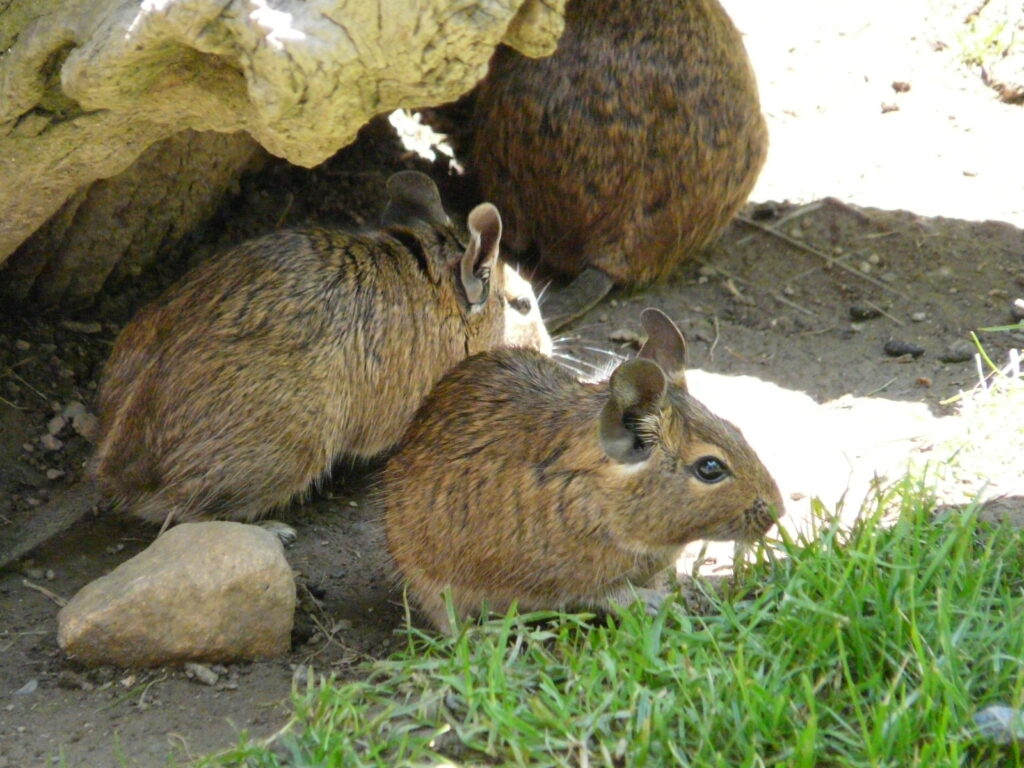
Precautions When Feeding Hay
Insects and parasite eggs
Hay can contain insects and parasite eggs. It’s possible that, even store-bought hay, contains insects or parasites. The most common insect in hay is the straw or hay itch mite.[6]http://bohart.ucdavis.edu/uploads/5/6/2/5/56256413/note_43_hay_itch_mites.pdf These mites can bite you and your animals and can cause irritating rashes.
It can be difficult to get rid of these mites so some people take the precaution of freezing the hay for up to 72 hours before feeding it to their animals. You can leave the hay in the product bag. Of course, you should let the hay defrost before you give it to them.
Wet or moldy hay
Hay can sometimes become wet and even moldy. You should never give wet or moldy hay to your degus. Wet and moldy hay can contain toxins which can cause serious health issues. Always ensure that your hay is dry (store it in a dry place) and doesn’t have a bad smell.
Dusty hay
Hay is always dusty, but hay with too much dust can contain mold spores. There can also be other causes for too dusty hay but in either case, you don’t give hay that is too dusty. Shifting the hay through your fingers, you can easily notice that your hay has too much dust.
You can soak the hay in water and let it sun dry until it is completely dry. Some people also steam the hay to get rid of dust.
Best Hay for Degus
Timothy hay
Timothy hay is probably the most popular choice of hay for most pet rodents and rabbits. It’s a quality hay that has the proper nutrients. It can be given daily to your degus but can also be mixed with other hays.
Orchard hay
Orchard hay is a green grass hay that has a slightly fruity smell. It is one of the more popular choices of hay for pet rodents although it might not always be available in your region.
Meadow hay
Meadow hay is a hay that consists of different grasses. It can also contain bits of other plants. Meadow hay usually is a bit cheaper than Timothy hay but is a good hay to feed to your degus. It can also be mixed with Timothy hay.
Alfalfa hay
Alfalfa hay is hay that has a very high calcium to phosphorus ratio and contains around 16% protein, which is much more than other hays.
Although alfalfa hay can be given to adult degus, it should only be given occasionally because of the high protein content. Young degus can be given alfalfa hay more often.
Feeding Instructions
How much hay can degus eat?
Degus can eat as much hay as they like (ad libitum). So, you can give your degus as much hay as they can eat. You can, for example, provide their body weight in hay daily.
What kind of hay can degus eat?
Degus can eat different hay types although Timothy hay, orchard hay, and meadow hay are the most popular choices. You should always feed your degus quality hay, like Timothy hay. But you can also combine it with other types of hay to add a little variation.
How many times can degus eat hay?
Degus can eat hay the entire day and each day of the week. So there is no limit to how many times you can give hay to degus. The same goes for grass, although you’ll need to watch for possible bloating.
Related Questions
Can degus eat hay instead of grass?
Degus can eat hay instead of grass. Hay is also considered safer for degus to eat because it’s dried grass. Fresh grass can, if eaten too much, cause bloating. Most degus will love hay more than grass.
Can degus eat too much hay?
A degu can eat as much hay as it wants. They will stop eating hay when they’ve eaten enough. Most hay can be eaten as much as they want, although alfalfa hay shouldn’t be given daily.
Want to Learn More?
If you’re interested in learning more about degus as pets, please read the following articles:
If you’re interested in getting degus as pets, you should read our beginner’s guide to keeping degus as pets and our degu care guide.
References
| ↑1 | See for example https://animaldiversity.org/accounts/Octodon_degus/#food_habits and https://lafeber.com/vet/basic-information-for-degus/ |
|---|---|
| ↑2 | https://nationalzoo.si.edu/animals/degu |
| ↑3 | Edwards, M. (06 2009). Nutrition and Behavior of Degus (Octodon degus). The veterinary clinics of North America. Exotic animal practice, 12, 237–253, viii. doi:10.1016/j.cvex.2009.01.003 |
| ↑4 | https://www.rspca.org.uk/adviceandwelfare/pets/rodents/degus/diet |
| ↑5 | Meredith, A., & Redrobe, S. (2002). BSAVA manual of exotic pets (No. Ed. 4). British Small Animal Veterinary Association. |
| ↑6 | http://bohart.ucdavis.edu/uploads/5/6/2/5/56256413/note_43_hay_itch_mites.pdf |


